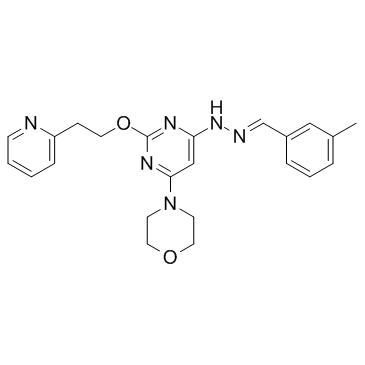541550-19-0
| Name | N-[(E)-(3-methylphenyl)methylideneamino]-6-morpholin-4-yl-2-(2-pyridin-2-ylethoxy)pyrimidin-4-amine |
|---|---|
| Synonyms |
UNII-GFW2K84S4L
apilimodum 4-{6-[(2E)-2-(3-Methylbenzylidene)hydrazino]-2-[2-(2-pyridinyl)ethoxy]-4-pyrimidinyl}morpholine STA-5326 apilimod |
| Description | Apilimod is a potent IL-12/IL-23 inhibitor, and strongly inhibits IL-12 with IC50s of 1 nM and 2 nM, in IFN-γ/SAC-stimulated human PBMCs and SAC-treated monkey PBMCs, respectively. |
|---|---|
| Related Catalog | |
| Target |
IC50: 1 nM (IL-12, human PBMCs), 2 nM (IL-12, monkey PBMCs) |
| In Vitro | Apilimod inhibited IFN-γ production induced by either IFN-γ/SAC or SAC in human PBMCs, with an IC50 of approximately 20 nM. Apilimod show some inhibition against IFN-γ/SAC-induced TNF-α and ConA-induced IL-5 from human PBMCs at high concentrations, but no suppressive effect against IL-1β, IL-2, IL-4, IL-8, and IL-18 in all cultures tested. The p35 and p40 promoter-driven luciferase activities are significantly induced after stimulation with IFN-γ/LPS or IFN-γ/SAC, and are completely suppressed by 100 nM Apilimod[1]. |
| In Vivo | Apilimod (10 mg/kg, p.o.) is effective not only when administered throughout the entire experiment, but also when administration is initiated on day 30 when disease is clearly measurable but not maximal. TA-5326 causes a significant reduction in cell number only in the Th1 model, with an average percentage of inhibition of 51%±8% relative to the vehicle control. Apilimod treatment has no effect in the Th2 setting[1]. Apilimod (5 or 20 mg/kg, p.o.) reduces the level of IL-12 p40 in serum without altering body weight in EAU mice. Oral administration of Apilimod reduces the severity of experimental autoimmune uveoretinitis (EAU) by clinical and histopathological analysis[2]. |
| Cell Assay | Cervical lymph node cells obtained from immunized mice on day 18 (2×105 cells/well) arecultured in 0.2 mL RPMI 1640 containing 10 mM HEPES, 0.1 mM nonessential amino acid, 1 mM sodium pyruvate, 100 U/mL penicillin, 100 μg/mL streptomycin, 1×10-5 M 2-mercaptoethanol, 10% FCS, and 10 μg/mL IRBP1-20. For cytokine assay, supernatants are collected after 72 hours and analysed for IFN-γ, IL-4 and IL-17 by quantitative capture ELISA using quantikine ELISA kits and mouse IL-17 ELISA Ready-SET-Go kits. Cell proliferation is evaluated using a cell proliferation assay. |
| Animal Admin | In most experiments, 5 mg/kg or 20 mg/kg Apilimod or vehicle only (0.5% carboxyl methyl cellulose) is orally administered once a day for six days a week from day 0 to day 14 after immunization. In the effector phase experiments, 20 mg/kg Apilimod or vehicle is orally administered once a day, from day 9 to day 14 after immunization. |
| References |
| Density | 1.2±0.1 g/cm3 |
|---|---|
| Boiling Point | 655.1±65.0 °C at 760 mmHg |
| Molecular Formula | C23H26N6O2 |
| Molecular Weight | 418.491 |
| Flash Point | 350.0±34.3 °C |
| Exact Mass | 418.211731 |
| PSA | 84.76000 |
| LogP | 4.04 |
| Appearance | white solid |
| Vapour Pressure | 0.0±2.0 mmHg at 25°C |
| Index of Refraction | 1.637 |
| Storage condition | -20℃ |
